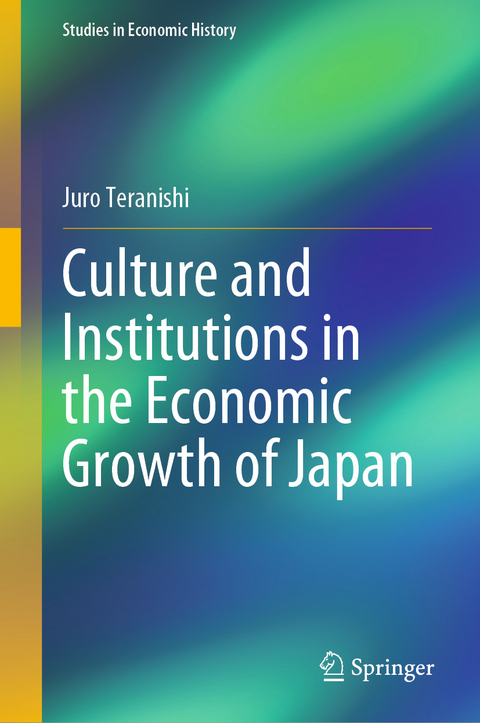
Culture and Institutions in the Economic Growth of Japan
Springer Verlag, Japan
978-4-431-55626-8 (ISBN)
In the Occident, institutions have been pivotal in structuring and ordering the market economy and coordinating incentives of economic agents, as is emphasized by Douglas North. The author of this book argues that culture, defined as historically transmitted beliefs and values specific to each nation, may fulfill similar roles by establishing conventions and norms of behavior of individuals.
Japan before the Meiji Restoration (1868) seems to be a typical case. The book presents an analysis of the formation of its internalized part of mental model, owing to religious reform in Buddhism in the thirteenth century and the consequent emergence of commerce-based growth driven by a decline in transaction costs in the Tokugawa Era, from the seventeenth through the mid-nineteenth centuries. Institutions had been largely inefficient due to serious cultural conflicts among classes, especially between the samurai and aristocrats. The relative costs of establishing and enforcing institutions were low in the Occident where internalized beliefs were based on the concept of public, by and large common among individuals; by contrast, in Japan, where internalized beliefs were strongly influenced by others nearby, that differed significantly among individuals, the costs were high because of difficulty in sharing mental models. The economic development of the Occident owed largely to the development of industrial technology nurtured under the development of various institutional devices to coordinate activities, whereas the economic growth of Japan during the Tokugawa Era was causedby the decrease in transaction costs in commercial activities owing to the standardization of conduct nurtured through the deliberate development of culture and to the efforts of small producers enhanced by religious motivation.
After the Meiji Restoration, Occidental institutions and industrial technology flowed into Japan rapidly, and the Japanese enthusiastically absorbed the Occidental cultural system crystalized in Enlightenment values. At the same time, the struggle of Meiji leaders to establish national integrity and spirit was an attempt to adapt imported Occidental institutions to the traditional internalized culture and to maintain the merits of historical tradition as much as possible. The book argues that it is not easy to implement fusion or substitution of traditional internalized culture with any “advanced” culture of foreign societies.
Juro Teranishi is a professor emeritus of Hitotsubashi University. From 1970 through 2006, he was a professor at the Institute of Economic Research of Hitotsubashi University and a visiting professor at Yale University from 1976 to 1978, and at the Australian National University in 1985 and 1986. He also served as an adviser to the Institute of Monetary and Economic Studies of the Bank of Japan, as a counselor of the Association of Economics of The University of Tokyo, and as an adviser to the Bureau of High-Level Education of the Ministry of Education and Science. He was on the editorial board of the Pacific-Basin Finance Journal, of Oxford Development Studies, and of The Developing Economies. Among the books he has edited are The Japanese Experience of Economic Reforms (St. Martin's and Macmillan Press, 1993) and Designing Financial Systems in East Asia and Japan (Routledge Curzon, 2004).
1 The culture and institutions of Japan.- 2 Mental models and the cost of institutions.- 3 The process of long-term growth before the Meiji Restoration.- 4 Religious changes in Kamakura-era Japan.- 5 Institutions and trust level during the Muromachi era.- 6 Cultural foundations of Tokugawa economic growth.- 7 Japanese economy and culture after the Meiji Restoration.- 8 Culture and collective behavior in Japan.- References.- Indices.
| Erscheint lt. Verlag | 15.12.2020 |
|---|---|
| Reihe/Serie | Studies in Economic History |
| Zusatzinfo | 1 Illustrations, black and white; XXI, 387 p. 1 illus. |
| Verlagsort | Tokyo |
| Sprache | englisch |
| Maße | 155 x 235 mm |
| Themenwelt | Geschichte ► Teilgebiete der Geschichte ► Wirtschaftsgeschichte |
| Geisteswissenschaften ► Religion / Theologie | |
| Wirtschaft ► Allgemeines / Lexika | |
| Wirtschaft ► Volkswirtschaftslehre ► Makroökonomie | |
| Schlagworte | Buddhism • Economic Behavior • Family Systems • Japanese economy • Religious Foundation • Socioeconomic Systems |
| ISBN-10 | 4-431-55626-5 / 4431556265 |
| ISBN-13 | 978-4-431-55626-8 / 9784431556268 |
| Zustand | Neuware |
| Informationen gemäß Produktsicherheitsverordnung (GPSR) | |
| Haben Sie eine Frage zum Produkt? |
aus dem Bereich


